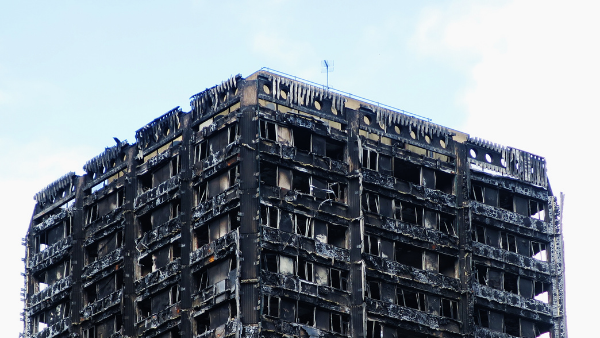Background
The Grenfell Tower Fire took place on 14 June 2017. The fire resulted in 72 fatalities and it was the greatest loss of life in a residential fire since the Second World War.
Following the fire, the Government commissioned the Independent Review of Building Regulations and Fire Safety. The Review, led by Dame Judith Hackitt, highlighted ‘deep flaws‘ in the current regulatory system covering high-rise and complex buildings and recommended that the Government should address the following:
- There is a lack of clarity on roles and responsibilities within the industry which ‘precludes robust ownership of accountability‘. The report therefore recommends a very clear model of risk ownership, with clear responsibilities for the Client, Designer, Contractor and Owner to demonstrate the delivery and maintenance of safe buildings.
- There is ignorance within the industry towards regulations and guidance which is often overlooked by those who should read it and the guidance is often misinterpreted. Accordingly a new, simple and effective regulatory framework was recommended which is outcomes-based as opposed prescriptive rules and complex guidance.
- The above issues have facilitated a ‘cultural issue‘ within the industry where there is a lack of emphasis on delivering the best quality building possible, in order to ensure that ‘residents are safe, and feel safe’. The Report recommends that a new framework should put residents at the heart of a new system of building safety, empowering them with more information and engaging them on how risks are managed in their building.[1]
Draft Building Safety Bill
Published in July 2020, the draft Building Safety Bill puts the wheels in motion of the Government’s commitment to fundamentally reform of the building safety system. Those involved throughout the lifecycle of a building, – its design, construction, ownership and management – should consider the implications of the Bill and its impact on their future operations.
‘Higher-Risk’ residential buildings
Buildings that pose a ‘higher risk’ are one of the key areas of scrutiny in the Bill. These are new and existing residential buildings defined as being:
- 18 metres or more above ground level; or
- a building which contains more than 6 storeys (ignoring any storey which is below ground level).
The building must also contain:
- two or more dwellings (i.e. house or flat); or
- two more rooms used for residential purposes (e.g. supported accommodation); or
- student accommodation.
Residential care homes, prisons/detention centres and temporary accommodation including hotels, hostels, guest houses, hospitals and hospices are excluded from the definition although there is scope for the Secretary of State to widen the definition in the future. [2]
Structure of the Bill
The Bill is arranged into the following 5 parts:
- Part 1 provides a brief overview of the Bill.
- Part 2 introduces a new Building Safety Regulator (‘BSR’) with powers to enforce higher standards of safety across all buildings to ensure the safety of people in or about buildings.
- Part 3 deals with amendments to the Building Act 1984 including replacing the local authority with the Building Safety Regulator as the building control authority for enforcing the requirements of building regulations for a) higher-risk buildings, b) buildings which are to be higher-risk buildings and c) buildings which become higher-risk as a result of building work being undertaken.
- Part 4 introduces the new roles of the ‘Accountable Person’ (usually a management company or the owner of the building) and Building Safety Manager and sets out their duties in relation to safety risks in their building.
- Part 5 sets out supplementary information, including the creation powers to make provisions for the regulation of all construction products placed on the UK market allowing them to be withdrawn from the market if they present a risk.
The Bill extends to England and Wales only, (save for Part 1, which contains an overview of the Bill and extends to the whole of the UK).
Part 2 – Building Safety Regulator
The BSR will form a new division within the Health and Safety Executive. The Explanatory Notes which accompany the Bill state that its role will broadly cover the following objectives:
- Implementing the new, more stringent regulatory regime for higher-risk buildings
- Overseeing the safety and performance of all buildings. This objective has 2 key strands, namely:
- reviewing and overseeing the performance of other building control bodies ( i.e. local authorities and Approved Inspectors) and having the power to impose sanctions for poor performance
- Reviewing and delivering guidance on current and new building standards and safety risks such as changes in building regulations.
- Assisting and encouraging competence among the built environment industry, and registered building inspectors.[3]
The BSR will fulfil its role with the assistance of various committees. The first of which will be the Building Advisory Committee. This newly-appointed committee will replace the existing Building Regulations Advisory Committee for England (BRAC), and will advise the BSR about matters connected with most of its building functions. A further Committee on Industry Competence which will address the knowledge, skills and experience needed to carry out specific roles. Finally, a Residents’ Panel will advise the Building Safety Regulator on strategy, policy, systems and guidance which will be of particular interest to residents of higher-risk buildings.
Enforcement Powers
The BSR will be given the power to issue compliance notices and provide a deadline by which issues of non-compliance need to be rectified. Furthermore, during the design and construction phase, the BSR will also be able to issue stop notices which effectively postpone work until the issue on non-compliance is rectified.
Failure to comply with compliance and stop notices will be a criminal offence, with a maximum penalty of up to two years in prison and an unlimited fine.
The BSR is also authorised to appoint a multi-disciplinary team of appropriately qualified individuals to assist the BSR in carrying out its enforcement related functions. Such powers may include the written authority to visit a building site to inspect the construction of the higher-risk building and ensure it complies with building regulations.
Part 3 – Amendments to the Building Act 1984
Reduced Power of Local Authorities
The Bill amends and creates further provisions within the Building Act 1984. Of particular note is the replacement of the local authority with the Building Safety Regulator as the building control authority for higher-risk buildings.
Accordingly, the power to enforce the requirements of building regulations in respect of higher-risk buildings is taken away from local authorities and centralised under the control of the BSR. Local authorities (or a registered building control approver) will remain as the building control authority for other buildings.
Dutyholder regime
Existing building regulations do not stipulate particular competence requirements of persons carrying out building work, save that ‘building work shall be carried out in a workmanlike manner.‘[4] However, this provision emphasises the quality of the work as opposed to competence of the individual undertaking the work. The Construction (Design and Management) Regulations 2015 do contain competence requirements for contractors and designers but the regulations do not contain specific provisions relating to higher-risk buildings.
One of the BSR’s core functions is to implement a more rigorous regime for higher-risk buildings. Through the introduction of a dutyholder regime, the BSR will be able to ensure that the responsibility for managing building risks lies with the appropriate person or entity that created the risk in the first instance.
The dutyholders will be individuals or entities who are responsible for particular stages throughout the lifecycle of a building. They include those listed under the Construction (Design and Management) Regulations 2015. Accordingly, the Client, Principal Designer, Principal Contractor, Designer and Contractor will all bear accountability responsibilities for managing risks.
In addition to the requirements of the CDM Regulations, a dutyholder’s ability to bear its responsibilities will be assessed through competence requirements. The Explanatory Notes to the Bill state that for individuals, the competence requirements will relate to their skills, knowledge, experience and behaviours.[5]
Wider guidance, which will provide examples of the skills, skills, knowledge, experience and behaviours, has not yet been published and once the Bill has received Royal Assent, Secondary Legislation will be introduced enforce these competence requirements.
Gateway Points
The amendments to the Building Act also allow for the creation of a series of Gateways which will be established to ensure that building safety risks are considered at each stage of a higher risk building’s design and construction:
- Gateway 1: the planning phase – mirroring the existing process by which planning permission is granted in England.
- Gateway 2: pre-construction phase. In-line with the guidance, dutyholders will be required to submit key information to the Building Safety Regulator to demonstrate how the building, once built, will comply with the requirements of building regulations.
- Gateway 3: the completion / final certificate phase pre-occupation where and the building control body assesses whether the work has been carried out in accordance with the building regulations.[6]
Central to the Bill’s objective of ensuring that each stage of a building’s lifecycle is closely monitored is the concept of the golden thread of information. This information will include fire and structural safety building information held digitally to specific standards and will be used to ensure that ‘those responsible for the building have the required information to manage building safety during throughout the lifecycle of the building.’[7]
Statutory guidance will be issued to support the golden thread concept and will specify the information and documentation that must be obtained and kept, and the standards to which these documents and information must be stored and maintained.
Parts 4 & 5
As noted above, Part 4 set out the duties of the Accountable Person; the dutyholder for higher-risk buildings in occupation, and the Building Safety Manager, whose role is to aid the Accountable Person in the day-to-day management of fire and structural safety in the building. The duties of the Accountable Person include:
- Registering the building and applying for a Building Assurance Certificate. The certificate will be granted by the BSR if it is satisfied that the Accountable Person is taking reasonable steps to prevent major incidents occurring as a result of building safety risks. If granted the certificate must be displayed in a prominent position in the building.
- Provide a ‘Safety Case Report’ which is a document that highlights all the key components of the safety case with references to supporting documentation. The Report and its evidence show how building safety risks are being managed, contained within the golden thread of information.
Part 5 contains provisions which aim to ensure that all construction products sold within the UK market are governed by a regulatory regime. The Building Safety Bill will do this by:
- Creating a statutory list of ‘safety critical’ construction products which comprises of products that would risk causing death or serious injury to any person in the event of a failure of the product.
- Requiring construction products that are not covered by the existing regime or included on the statutory list to be a safe product.
The Bill creates provisions for monitoring compliance which include powers conferred on the local authority to issue notices which can have any of the following effects:
- requiring a person to warn others of the risks attaching to a product
- requiring the withdrawal of a product from the market
- requiring the recall of a product from persons to whom it has been supplied.
The penalties for non-compliance include a fine, imprisonment not exceeding 51 weeks (in England) or both.
The guidance notes stipulate that both Trading Standards and the Secretary of State will be given enforcement powers for all the existing and new parts of the regulatory regime.[8]
Comment
The Bill has been widely recognised as an important regulatory shift in the construction industry. Whilst the intensive nature of the new regulatory scheme will likely result in buildings costing more and taking longer to construct, these consequences are a small sacrifice to ensure the safety of buildings and the lives of those occupying them.
Whilst it is not immediately clear how long it will take for the Bill to become law, the wider real estate sector should familiarise itself with the provisions of the Bill in respect of the construction, ownership and maintenance of buildings – especially in the residential sector.
We shall be hosting a webinar on this topic in due course. To receive notification of our webinars subscribe here. In the meantime, if you would like to discuss any points arising from this topic then please contact Michelmores’ Construction and Engineering team.
[1] See Building a Safer Future – Independent Review of Building Regulations and Fire Safety: Final Report, page 5. Available at:
[2] See Building Safety Bill Explanatory Notes, page 39. Available at:
https://www.gov.uk/government/publications/draft-building-safety-bill
[3] Ibid, page 9
[4] The Building Regulations 2010 Part 2 Regulation 7 (b). Available at:
https://www.legislation.gov.uk/uksi/2010/2214/regulation/7/made
[5] Ibid, page 62
[6] Ibid, page 12
[7] Ibid, page 182
[8] Ibid, page 17
Michelmores Property Development Club
The Michelmores Property Development Club (PDC) is a forum for developers and property professionals to connect and share knowledge. The Club is celebrating its 22nd...
Michelmores Property Awards
Celebrating the best of property, development and construction in the South West The Michelmores Property Awards celebrate the best property, development and construction projects in...


